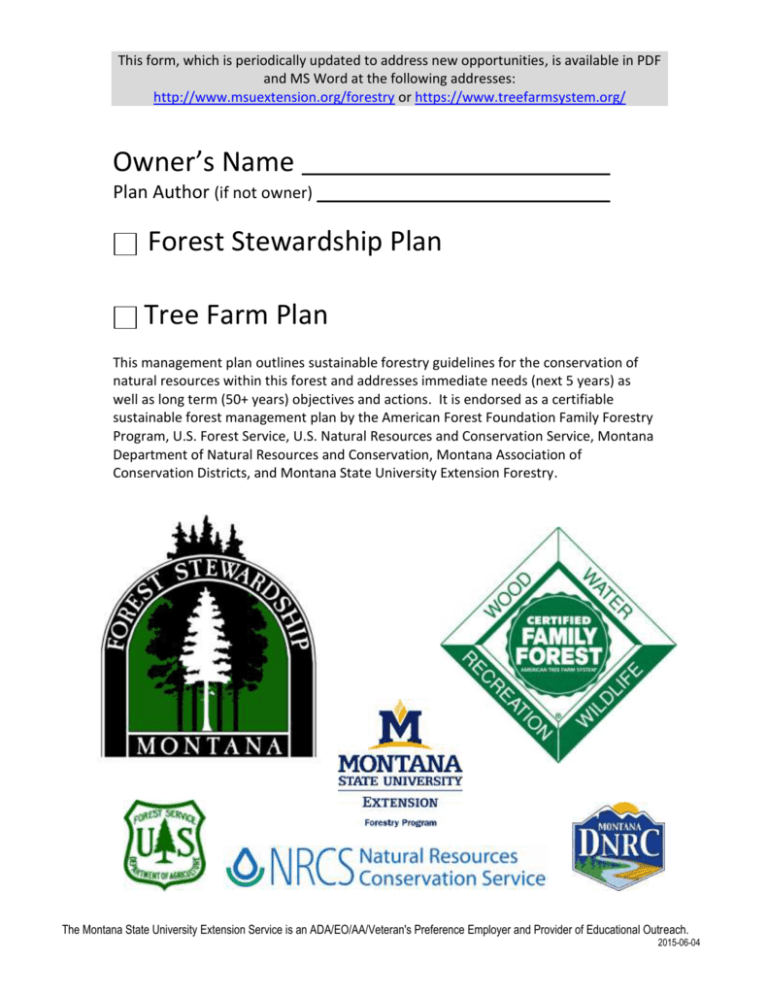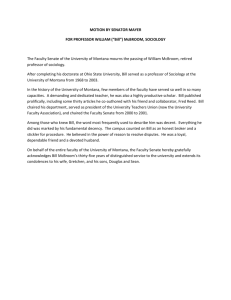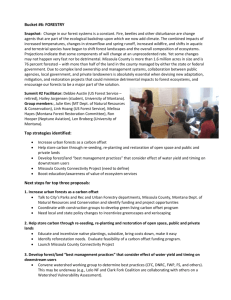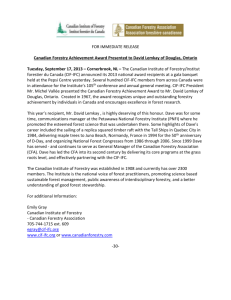Forest Stewardship Plan
advertisement

This form, which is periodically updated to address new opportunities, is available in PDF and MS Word at the following addresses: http://www.msuextension.org/forestry or https://www.treefarmsystem.org/ Owner’s Name Plan Author (if not owner) Forest Stewardship Plan Tree Farm Plan This management plan outlines sustainable forestry guidelines for the conservation of natural resources within this forest and addresses immediate needs (next 5 years) as well as long term (50+ years) objectives and actions. It is endorsed as a certifiable sustainable forest management plan by the American Forest Foundation Family Forestry Program, U.S. Forest Service, U.S. Natural Resources and Conservation Service, Montana Department of Natural Resources and Conservation, Montana Association of Conservation Districts, and Montana State University Extension Forestry. 1 The Montana State University Extension Service is an ADA/EO/AA/Veteran's Preference Employer and Provider of Educational Outreach. 2015-06-04 Forest Stewardship Plans are stored as an electronic copy with the signature page and map removed and stored separately as a hard copy to protect your privacy. Each plan is assigned a number so that the two parts can be made available to you if needed. Record of Forest Stewardship Certification Advisor Name Phone Date of Property Visit MU’s Verified # Acres Verified Approved By (Stewardship Advisor – certifies that this Forest Management Plan meets the requirements of the federal Forest Stewardship Program.) Forest Landowner(s) Signature(s) Please note: Informal updates to the plan can be made with handwritten notes. Be sure to include a date and initial these notes throughout the management plan. American Tree Farm Program I certify that this Forest Management Plan meets the requirements of the American Forest Foundation’s American Tree Farm System. _____________________ ATFS Inspecting Forester Number Date Certified Tree Farm Number: (e.g. MT 1234) _______ Date of ATFS Certification: _______ Your Tree Farm plan should be saved and presented at re-inspections which are completed every 5 years, or sooner if yours is selected as a mandatory inspection or audit by National Tree Farm. If you choose MT Tree Farm can also store your plan in a secure location so that it can be made available to you in case you misplace your copy. Please select one of the options below: __ I will keep a copy of my plan, MT Tree Farm does not need to store a copy. __ MT Tree Farm may store a copy of my plan. NRCS Incentive Programs I certify that this Forest Management Plan meets the requirements of the USDA Environmental Quality Incentives (EQIP) Program and/or the Quality Criteria for forest activity plans in Section III of the USDA NRCS Field Office Technical Guide. _____________________ Technical Service Provider Number Date ________________________ District Conservationist Montana State University Extension Forestry Date 1 Contour Map Attach property map (topographic) here. Identify Property Boundaries and Management Units Montana State University Extension Forestry 2 Aerial Photo Attach aerial photograph here. For free aerial photo downloads http://earth.google.com/ Montana State University Extension Forestry 3 Property Ownership Landowner(s) (and representative, if different) Mailing Address(es) Phone Number(s) E-Mail(s) Date of Original Plan Completion Revision date(s) Property and Landscape Description Legal property description Nearest city or town County Total ownership acreage Total forested acreage Total acreage covered by this plan Number of unique stands of trees or management units Do you reside on the property? Yes Average aspect (check): S N No E W Flat Average elevation Basic topography (estimate percent of total acreage that is) Complex topography (many steep ravines and aspects) ________________ Simple topography (few ravines and changes of aspect) ________________ Percent of land that is Flat-Gentle (0-20% slope) ___________ Moderate Slope (20-40% slope) _________ Improved Road Conditions (check): Steep Slope (> 40% slope) __________ Excellent (100% accessible) Fair (at least 50%) Good (at least 80%) Poor (less than 25%) Estimated improved road length (bulldozed with graveled surface) Estimated unimproved road length (bulldozed with but original soil/bedrock) Estimated total permanent skid trail length (drivable but no earthwork) Estimated cumulative stream length class I ________ class II ________ class III _______ Are any streams on Montana’s Impaired Stream List? Check website: http://www.deq.mt.gov Yes No Montana State University Extension Forestry Unknown 4 Property History A brief description of ownership record, past management activities, and development of the ownership. (Based on personal knowledge, property records, and local information sources. Also consider what evidence you see on the ground such as: stumps, skid trails, etc. Can be added to in the future) Montana State University Extension Forestry 5 Forest Stewardship Goals The principal management objectives for the ownership. (Refer to worksheet Goals for my Forest Land). Write your goals in the spaces below. Place a 1 in the box next to your most important goal, a 2 in front of your next most important goal, and so forth. If goals are equal then give them the same number. Feel free to add or change headings to better fit your specific goals. Treestimber): Fire protection: Wildlife: Range/livestock: Understory vegetation & weeds: Building sites (home, barn, etc.: Aesthetics: Recreation: Legacy: Revenue: : : Montana State University Extension Forestry 6 Stand Level Information Your property may have multiple management units that are either defined by unique site characteristics, management actions that you desire to implement or a combination of both. For each stand or management unit, write what your management objectives and desired future conditions are and a brief description of the forest management unit and its condition. Descriptors can include: slope, aspect, forest structure, tree species composition, health and appearance, % crown cover, wildlife & livestock use and potential, soil properties. For a more detailed analysis use the Plot Form Summary, Inventory Short List, or Stand Analysis Form to help with this section. http://www.msuextension.org/forestry/downloads.htm Unit 1 General current description: Acres Objectives: Desired condition: Montana State University Extension Forestry 7 Unit 2 Acres General current description: Objectives: Desired condition: Unit 3 Acres General current description: Montana State University Extension Forestry 8 Objectives: Desired condition: Unit 4 Acres General current description: Objectives: Desired condition: Montana State University Extension Forestry 9 Unit 5 Acres General current description: Objectives: Desired condition: Add more pages as needed (additional pages at end) Montana State University Extension Forestry 10 Desired Future Condition (Trees) MU _____ Complete for each Management Unit Length of planning period ______5yr ______other Add more pages as needed – (Additional pages at end) Desired tree species and expected longevity (maximum age you expect trees to reach before they die of natural causes or are harvested) Desired Tree Species Percent of Stand Age 1. 2. 3. 4. 5. 6. Desired species to naturally regenerate PP ponderosa pine DF Douglas-fir LPP lodgepole pine WL larch GF grand fir ES Engelmann spruce WRC w. red cedar WH western hemlock WP white pine SAF sub-alpine fir LP limber pine RMJ rocky mtn. juniper QA aspen CW cottonwood GA green ash Desired species to plant Desired Tree Distribution (Bird’s-eye view of forest-(check one) Wild stand Evenly spaced Evenly spaced with openings Desired spacing (in feet) Large (>9“DBH) Pole (5-8”DBH) (ft) Seedling (<5”DBH) (ft) (ft) Size and shape of openings Desired structure: One canopy layer Two canopy layer Multi-layer/ Unevenaged Variable density spaced with openings Spacing (feet) 3x3 5x5 7x7 10x10 12x12 14x14 16x16 18x18 20x20 25x25 30x30 40x40 Montana State University Extension Forestry Trees/acre 4,840 1,742 889 436 302 222 170 134 87 70 48 27 11 Resource Elements This section relates to the natural resource elements found throughout the entire property. Some of the treatments related to these resources may qualify for federal and state incentive programs. For this section, include appropriate activities and treatments in the Management Activity Schedule and Tracking table as well as on the map(s). Complete the Activity Schedule and draw and label the areas of management on the map if using this plan as part of an incentive program application. There is no need to repeat this information in the stand specific section. For each resource element, consider: 1. What treatments/monitoring/protection are planned? 2. When will you implement treatments (season, year), follow-up activities, etc? 3. Where will the management take place: entire stand, part of a stand, acres? 4. Do you have applicable permits, professional assistance, and applications for the incentive programs? Special Sites & Social Considerations Home fire safety (defensible space, near home site) Recreation (what recreational uses will you pursue on your property – hiking,skiing, hunting, birdwatching, atv trails, camping etc. and where and when willyou pursue these. Do you need to modify sites for these?) Montana State University Extension Forestry 12 Access (Does your property restrict access to public lands, will you allow access across or to your lands, are the boundaries posted with appropriate contact information, have you considered Block Management with Montana Fish Wildlife and Parks) Roads (general maintenance, erosion potential, Best Management Practices, road surface condition, road runoff, drain-dips, culverts, stream crossings, weed control, time-of-year use) Adjacent Ownership Concerns (how does surrounding management affect your forest and how do your actions impact your neighbors? Consider aesthetic quality, wildfire concerns, privacy, wildlife movement and habitat, noxious weeds) Soil protection (Litter layer, understory vegetation, woody debris retention, nutrient cycling, microfauna) http://websoilsurvey.nrcs.usda.gov/app/HomePage.htm Special sites and their protection (including, archeological, cultural and historic sites - are there historical sites on your property that you wish to delineate, protect or contact anyone i.e. universities etc. about) Carbon sequestration(optional – will you pursue selling or leasing the carbon being sequestered on your property to someone else?) Montana State University Extension Forestry 13 Fish, Wildlife and Biodiversity Describe the resources on your property and the activities you are planning to accommodate your goals. Fish & wildlife – desired species (species lists, habitat improvement or creation, animal control, den sites, nest boxes, snag retention, access, hunting) State and federal threatened or endangered species - plants or animals (to request site specific information http://mtnhp.org/Requests/ ) Streams, wetlands, ponds, lakeshore (Plans and protection - is there a wetland or stream within your harvest area, is it properly marked Streamside Management Zone (SMZ) and are the appropriate laws being followed?) Permits needed (310 for stream/streambank disturbance or alteration) Montana State University Extension Forestry 14 Range Resource, Water and Soil Protection What goals do you have, or what steps will you take to conserve, protect and enhance your forest’s air, water and soil resources? Rangeland resources (if applicable - grasses, sedges, forbs, shrubs, nitrogen fixing plants, grazing animals, sustainable grazing guidelines, # pastures and animal rotation, water sources, salt block placement) Grazing animals (native and domestic that are present, in what numbers and time of year; or are you planning for them in the future and in what units) Weed management, invasive species (inventory, control, monitoring, prevention guidelines, consider integrated pest management) Montana State University Extension Forestry 15 Management of Forest Resources (If a stand is being treated, the general area can either be described or identify the impacted areas on your map) - Note MU’s in which you are planning activities. Protection from insects & diseases (mechanical treatments, chemical applications) Tree species to regenerate (Natural regeneration or planted – 1) How will this be achieved, 2) What time of year will actions take place, 3) How large an area, 4) How many seedlings or what spacing?) Non-commercial thinning treatments (species preference, spacing, time of year, debris abatement) Wildfire hazard reduction and fire resilience treatments (herbaceous and grassy fuels, dead woody fuels, live fuels, fire ladders, crown density, firebreaks, access, water) Montana State University Extension Forestry 16 Property Management Plan Constraints Other Considerations Montana State University Extension Forestry 17 Forest Management Activities Harvesting: Describe type of treatment and in what unit(s): Even-aged: clearcut, thinning; Uneven-aged: group select, single tree select, overstory removal, understory removal, etc. Treatment methods: ground based or skyline, time of year, type of harvest; seed tree, sanitation, etc. Slash management (leave slash at the stump, whole tree skid, burn piles, masticate, chip, leave and distribute woody debris, consider nutrient cycling and future fire hazard) Post-harvest activities (when and where will you burn, rehab and seed roads and landings, spray weeds?) Permits (where do you get slash hazard reduction agreement, 310 permit for stream crossings) Monitoring (how often and when do you plan on evaluating harvest units to ensure your overall forest management goals are being met?) Montana State University Extension Forestry 18 Stewardship Plan Activity Schedule and Record (MU or all MU’s combined) (Copy additional pages if needed) *NRCS Practice Code needed if practice will be submitted for cost share, otherwise leave blank. NRCS Practice Code* Dates Planned Completed Incentive Program(s) used? Net Cash Flow (optional) Cost Income Years 1-2 MU# Treatment Activity Short Description Treatment (Acres, Feet) Years 3-4 subtotal Years 5-6 subtotal Years 7-8 subtotal Years 9-10 subtotal subtotal TOTAL Montana State University Extension Forestry 19 Timber Sale Contract Checklist for Private Landowners and Loggers Unless a private landowner has the ability to personally harvest trees and transport them to a sawmill or other wood processing facility, the act of logging and transporting trees will be conducted by a contracted professional. The following is a checklist of issues a private landowner and logging contractor may wish to consider on a logging contract. Each of the items should be addressed in a contract to allow for a minimum probability of a dispute. Issues can be as detailed as both parties find acceptable and economically feasible. ___ Property location and legal description are clearly defined ___ Property boundaries and harvest units are clearly and accurately marked (logging trespass results in a minimum cost of 3x value of trees) ___ Property ownership is documented and type of ownership is specified (Individual, partnerships, corporations, etc.) ___ Insurance is documented (Any contractor working for a landowner must have Commercial General Liability $1 –million, Loggers Broad Form Property Damage Liability $1-million, Workers’ Compensation $100,000 or an Independent Contractor Exemption, and Automobile Liability $1-million. If they do not have these, the landowner will be held liable for any damage or personnel injury that may occur. Logging is a hazardous activity!) ___ Access to the property/harvest unit are specified and documented (To avoid trespass or the disturbance of sensitive areas access routes should be clearly delineated. If access across other ownerships is required, written and notarized documentation of access permission should be obtained) Insurance can be written to include owner and consulting forester. ___ Type of harvest is clearly specified for each harvest unit (Typically trees are marked both at eye level and on the stump, or harvest tree characteristics are defined by species, diameter, crown characteristic, or residual tree spacing) ___ Timing of harvest is specified (Dates when harvesting and/or other treatments need to be conducted or completed by) ___ Residual property specifications should be defined (This is as detailed as the landowner and contractor can agree upon. Issues can be the completeness of residual logging debris disposal, burn pile rehabilitation, grass seeding, skid trail rehab, noxious weed control, tree planting, noncommercial thinning) ___ Hazard Reduction Permit has been acquired and responsible party designated (Under state law a hazard reduction permit must be obtained from the DNRC and a bond posted that covers the expense for meeting the HRA specifications. Either the landowner or contractor is responsible for this) Montana State University Extension Forestry 20 ___ Best Management Practices (BMP’s) and Streamside Management Zone (SMZ) responsibilities are designated (Compliance to Montana BMP’s is ultimately the landowners responsibility but should be specified in the contract. Similarly, compliance with SMZ’s are state law and their implementation should be specified) ___ Performance bond or contract penalty clauses some provision for compensation to the landowner for harvesting activities that deviate from specifications. Having the contractor post a bond is the best protection for the landowner but imposes a risk on the contractor. Contractors already post a performance bond with the state to comply with the Hazard Reduction Agreement) ___ Method of payment is clearly defined (Lump sum is one payment for the entire estimated log volume, this method may over or underestimate actual value but is simple and can be demanded in advance of the actual harvesting. Payment by unit is where payment for logs occurs based upon the actual scaled logs at the mill. Either the contractor pays an agreed upon percentage to the landowner or the mill pays agreed upon percentages separately to the contractor and landowner. Downfall is that in cases of salvaging dead and dying trees a delayed harvesting job can result in losses of standing tree value) ___ Method of scaling is defined (Either direct scaling or weight scaling are used. Direct scaling tends to be more accurate though each mill may use different defect deductions. Weight scaling works for large volume sales that have trees of similar species and diameter. In general logs should be trucked to the mill quickly following harvest or they lose significant water weight or for most accurate conversions a continuous representative sample of logs should be check scaled and weighed) ___ Notification (It is defined if and when the contractor or landowner needs to notify the other party about when activities are to start or end and the type of format – written, email, telephone. This is to avoid issues with blocked access, noise, etc.) ___ Expiration date (Any contract should have a defined end date after which the contract is no longer valid) ___ Notarization (Any legally binding document should have signatures notarized) *** This is simply a recommended check list compiled from a variety of sources including The Montana Logging Association for a harvesting contract. Any contract can be challenged. It is always advised that a contract be reviewed by an attorney. You may also want an attorney’s fees recovery statement in the document that will allow for recovery of legal fees should a dispute require legal action. *** Montana State University Extension Forestry 21 Supplemental pages for unit/stand descriptions and desired future conditions Montana State University Extension Forestry 22 Additional Stand Level Information Unit ____________________ Acres General current description: Objectives/Desired future condition: Unit ____________________ General current description: Acres Objectives/Desired future condition: Montana State University Extension Forestry 23 Desired Future Condition (Trees) MU _____ Complete for each Management Unit Length of planning period ______5yr ______other Add more pages as needed – (Additional pages at end) Desired tree species and expected longevity (maximum age you expect trees to reach before they die of natural causes or are harvested) Desired Tree Species Percent of Stand Age 1. 2. 3. 4. 5. 6. Desired species to naturally regenerate PP ponderosa pine DF Douglas-fir LPP lodgepole pine WL larch GF grand fir ES Engelmann spruce WRC w. red cedar WH western hemlock WP white pine SAF sub-alpine fir LP limber pine RMJ rocky mtn. juniper QA aspen CW cottonwood GA green ash Desired species to plant Desired Tree Distribution (Bird’s-eye view of forest-(check one) Wild stand Evenly spaced Evenly spaced with openings Desired spacing (in feet) Large (>9“DBH) Pole (5-8”DBH) (ft) Seedling (<5”DBH) (ft) (ft) Size and shape of openings Desired structure: One canopy layer Two canopy layer Multi-layer/ Unevenaged Variable density spaced with openings Spacing (feet) 3x3 5x5 7x7 10x10 12x12 14x14 16x16 18x18 20x20 25x25 30x30 40x40 Montana State University Extension Forestry Trees/acre 4,840 1,742 889 436 302 222 170 134 87 70 48 27 24 Desired Future Condition (Trees) MU _____ Complete for each Management Unit Length of planning period ______5yr ______other Add more pages as needed – (Additional pages at end) Desired tree species and expected longevity (maximum age you expect trees to reach before they die of natural causes or are harvested) Desired Tree Species Percent of Stand Age 1. 2. 3. 4. 5. 6. Desired species to naturally regenerate PP ponderosa pine DF Douglas-fir LPP lodgepole pine WL larch GF grand fir ES Engelmann spruce WRC w. red cedar WH western hemlock WP white pine SAF sub-alpine fir LP limber pine RMJ rocky mtn. juniper QA aspen CW cottonwood GA green ash Desired species to plant Desired Tree Distribution (Bird’s-eye view of forest-(check one) Wild stand Evenly spaced Evenly spaced with openings Desired spacing (in feet) Large (>9“DBH) Pole (5-8”DBH) (ft) Seedling (<5”DBH) (ft) (ft) Size and shape of openings Desired structure: One canopy layer Two canopy layer Multi-layer/ Unevenaged Variable density spaced with openings Spacing (feet) 3x3 5x5 7x7 10x10 12x12 14x14 16x16 18x18 20x20 25x25 30x30 40x40 Montana State University Extension Forestry Trees/acre 4,840 1,742 889 436 302 222 170 134 87 70 48 27 25 Desired Future Condition (Trees) MU _____ Complete for each Management Unit Length of planning period ______5yr ______other Add more pages as needed – (Additional pages at end) Desired tree species and expected longevity (maximum age you expect trees to reach before they die of natural causes or are harvested) Desired Tree Species Percent of Stand Age 1. 2. 3. 4. 5. 6. Desired species to naturally regenerate PP ponderosa pine DF Douglas-fir LPP lodgepole pine WL larch GF grand fir ES Engelmann spruce WRC w. red cedar WH western hemlock WP white pine SAF sub-alpine fir LP limber pine RMJ rocky mtn. juniper QA aspen CW cottonwood GA green ash Desired species to plant Desired Tree Distribution (Bird’s-eye view of forest-(check one) Wild stand Evenly spaced Evenly spaced with openings Desired spacing (in feet) Large (>9“DBH) Pole (5-8”DBH) (ft) Seedling (<5”DBH) (ft) (ft) Size and shape of openings Desired structure: One canopy layer Two canopy layer Multi-layer/ Unevenaged Variable density spaced with openings Spacing (feet) 3x3 5x5 7x7 10x10 12x12 14x14 16x16 18x18 20x20 25x25 30x30 40x40 Montana State University Extension Forestry Trees/acre 4,840 1,742 889 436 302 222 170 134 87 70 48 27 26








